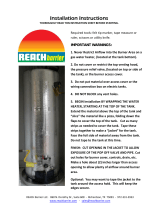
15
SECTION V: WATER CONNECTIONS
WARNING
Failure to install and maintain a new, listed temperature and pressure relief valve will release the manufacturer from any claim,
which might result from excessive temperature and pressures.
Hydrogen gas can be produced in an operating water heater that has not had water drawn from the tank for a long period of time
(generally two weeks or more). HYDROGEN GAS IS EXTREMELY FLAMMABLE. To prevent the possibility of injury
under these conditions, we recommend the hot water faucet to be open for several minutes at the kitchen sink before you use any
electrical appliance, which is connected to the hot water system. If hydrogen is present, there will be an unusual sound such as
air escaping through the pipes as hot water begins to flow. Do not smoke or have open flame near the faucet at the time it is
open.
Keep clear of the combination temperature and pressure relief valve discharge line outlet. The discharge may be hot enough to
cause scald injury. The water is under pressure and may splash.
CAUTION
If sweat fittings are to be used, DO NOT apply heat to the nipples in front or side of the water heater. Sweat the tubing to the
adapter before fitting the adapter to the water connections. It is imperative that heat is not applied to the nipples containing a
plastic liner.
INSTRUCTIONS FOR CONNECTIONS
1. BEFORE PROCEEDING WITH THE INSTALLATION, CLOSE THE MAIN WATER SUPPLY VALVE. After shutting
off the main water supply, open a faucet to relieve the water line pressure to prevent any water from leaking out of the pipes
while making the water connections to the water heater. The COLD water inlet and HOT water outlet are identified on the
water heater. Make the proper plumbing connections between the water heater and the plumbing system to the house. Install
a shut-off valve in the cold water supply line.
2. If this water heater is installed in a closed water supply system, such as the one having a back-flow preventer in the cold
water supply, provisions must be made to control thermal expansion. DO NOT operate this water heater in a closed system
without provisions for controlling thermal expansion. Warranties do not cover damages from thermal expansion such as
pressure bulges and/or deformities. Your water supplier or local plumbing inspector should be contacted on how to control
this situation.
3. After installation of the water lines, open the main
water supply valve and fill the water heater. While
the water heater is filling, open several hot water
faucets to allow air to escape from the water system.
When a steady stream of water flows through the
faucets, close them and check all water connections
for possible leaks.
4. Never operate the water heater without first being
certain it is filled with water.
SCALDING
This water heater can deliver scalding temperature water at any
faucet in the system. Be careful whenever using hot water to
avoid scalding injury. Certain appliances such as dishwashers
and automatic clothes washers may require increased temperature water. By setting the thermostat on this water heater to obtain the
increased temperature water required by these appliances, you might create the potential for scald injury. To protect against injury,
you should install an ASSE approved mixing valve in the water system. This valve will reduce point of discharge temperature by
mixing cold and hot water in branch supply lines. Such valves are available from the local plumbing supplier. The following chart
details the relationship of water temperature and time with regard to scald injury and may be used as a guide in determining the safest
water temperature for your applications.
Figure 9. Scald Warning
(52°C) can cause severe burns
are at highest risk of being
Children, disabled and elderly
instantly or death from scalds.
Water temperature over 125°F
Feel water before bathing or
before setting temperature
available.
showering.
Temperature limiting valves are
Review this instruction manual
at water heater.
scalded.






















